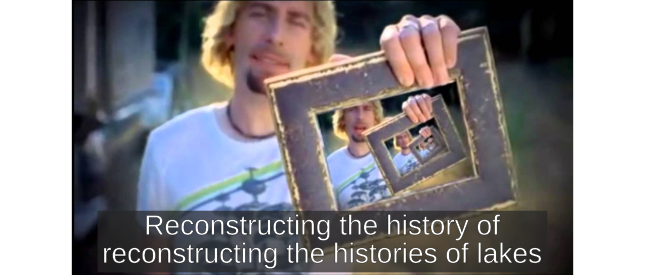“All have their worth and each contributes to the worth of the others” – John Ronald Reuel Tolkien
The fourth episode of our History of Paleolimnology picks up after the acid rain debates, with the science of paleolimnology ready to address many other environmental issues, including climate change.
By the 1990s, paleolimnology was a quantitative science that had answered some of the fundamental questions posed by acid rain. Although research on acidification continued, and does so to this day, once acid rain had been ‘solved’ many paleolimnologists turned their research focus to other ecological topics.
More Water Quality Problems
- Eutrophication
- Particularly on the Great Lakes
- Using diatoms to reconstruct nutrient concentrations
- Using diatoms to reconstruct biogenic silica and track broader landscape changes
- Global Warming/Climate Change
- Development of temperature-related transfer functions
- Limnogeology
- Investigating physical processes using paleolimnological approaches
- Geochemical and mineralogical aspects
- Using stable isotopes within the sediments as an indicator
- Deep Drilling Projects
- Frontier Paleolimnology
- High arctic and subarctic (e.g. Douglas et al. 1994)
- Antarctic
- High alpine and other extreme regions
More Paleolimnological Indicators
- Charcoal (fire history)
- Microplastics
- eDNA
- Spectral analyses
- Testate amoebae
Proliferation of Multi-proxy Analyses
It is interesting to note that the paleolimnology programme of the Surface Water Acidification Project (SWAP) was massively multi-proxy, but pre-dates the term.
“Cores from each of these sites were subjected to diatom, chrysophyte, cladoceran, chironomid, pollen, trace metal, sulphur, carbonaceous particle, magnetic mineral and polycyclic aromatic hydrocarbon (PAH) analysis.” (Battarbee and Renberg, 1990)
However, as time went on more and more smaller projects examine multiple indicators simultaneously.
Standardization of Methods
The standardization and collation of methods (particularly in the initial volumes of the Developments in Paleoenvironmental Research book series) greatly simplified the training of new paleolimnologists. The series now has 20 volumes and has expanded beyond lakes into a wide variety of paleoenvironmental topics.
- Volume 1: Basin Analysis, Coring, and Chronological Techniques
- Volume 2: Physical and Geochemical Methods
- Volume 3: Terrestrial, Algal, and Siliceous Indicators
- Volume 4: Zoological Indicators
- Volume 5: Data Handling and Numerical Techniques
Meta Analyses
- The increasing number of high quality studies allowed for datasets to be combined to ask questions at continental scales (e.g. Smol et al. 2005, Rühland et al. 2008)
- The large amount of sediments preserved in fridges around the world from lakes/ponds that no longer exist (i.e. disappearing arctic ponds)
- New class of studies comparing multiple cores taken from the same lake through time (e.g. Rydberg et al. 2020)
New Frontiers
- Growing beyond meta analyses, Big data approaches will allow for analyses at even large scales
- Environmental DNA
- Growth outside the classic paleolimnological focal points of North America and Europe, increasing the global perspective of paleolimnological change
That concludes the most definitive history of paleolimnology, available anywhere on the planet, in podcast form, so far as we know…

